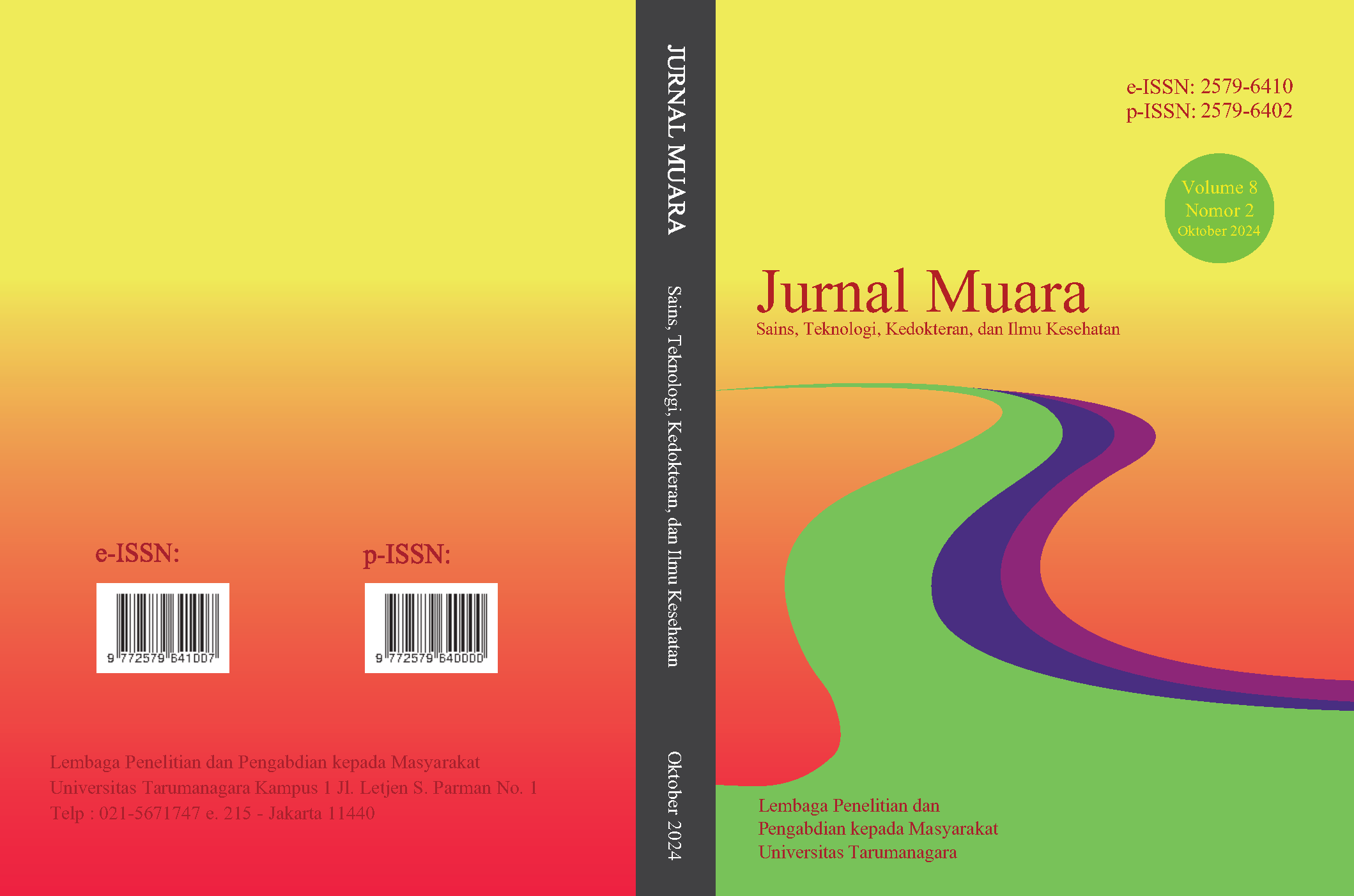FITOKIMIA, KAPASITAS ANTIOKSIDAN, TOKSISITAS, KADAR ALKALOID DAN FENOLIK TOTAL EKSTRAK UMBI BIT (Beta vulgaris L.)
Main Article Content
Abstract
Stres oksidatif merupakan ketidakseimbangan antara prooksidan dan antioksidan. Kelebihan Reactive Oxygen Species (ROS) dapat menyebabkan berbagai penyakit seperti penyakit kardiovaskuler hingga kanker. Antioksidan berperan dalam menghilangkan radikal bebas sehingga dapat mengurangi stres oksidatif. Untuk mengimbangi kekurangan antioksidan endogen, tubuh menggunakan antioksidan eksogen. Salah satu antioksidan eksogen adalah umbi bit (Beta vulgaris L.) yang dibudidayakan di negara-negara subtropis dan tropis. Tujuan dari penelitian ini adalah untuk mengetahui kandungan fitokimia, kapasitas total antioksidan, kadar fenolik total, kadar alkaloid total, dan toksisitas ekstrak umbi bit. Penelitian ini merupakan penelitian eksperimental in-vitro dan pemeriksaan bioassay. Ekstraksi dengan maserasi menggunakan metanol. Uji in-vitro yang terdiri dari uji fitokimia (Harborne), pengukuran kapasitas antioksidan dengan metode DPPH (Blois), penentuan kadar fenolik total (Singleton dan Rossi), penentuan kadar alkaloid total (Trivedi et al) dan pemeriksaan bioassay yaitu uji toksisitas dengan metoda BSLT (Meyer). Kandungan fitokimia yang terdapat pada ekstrak umbi bit terdiri dari alkaloid, antosianin, betasianin, fenolik, flavonoid, glikosida, kardioglikosida, kuinon, kumarin, saponin, tanin dan terpenoid. Ekstrak umbi bit mempunyai kapasitas antioksidan dengan = 839.314 ?g/mL, kadar fenolik total (288.125 ?g/mL), kadar alkaloid total (2.635 ?g/mL) dan toksisitas dengan =172.879 ?g/mL. Sehingga membuktikan ekstrak umbi bit memiliki kapasitas antioksidan yang lemah dan berpotensi sebagai antimitosis.
Article Details

This work is licensed under a Creative Commons Attribution-NonCommercial-ShareAlike 4.0 International License.
This work is licensed under a Jurnal Muara Sains, Teknologi, Kedokteran dan Ilmu Kesehatan Creative Commons Attribution-ShareAlike 4.0 International License.
Authors transfer copyright or assign exclusive rights to the publisher (including commercial rights)
References
Albasher, G., Almeer, R., Alarifi, S., Alkhtani, S., Farhood, M., Al-Otibi, F. O., Alkubaisi, N., & Rizwana, H. (2019). Nephroprotective Role of Beta vulgaris L. Root Extract against Chlorpyrifos-Induced Renal Injury in Rats. Evidence-Based Complementary and Alternative Medicine, 1.
Aziz, M., Diab, A., & Mohammed, A. (2019). Antioxidant Categories and Mode of Action. Antioxidants, 1–3.
Bahramsoltani, R., Farzaei, M., & Rahimi, R. (2014). Medicinal plants and their natural components as future drugs for the treatment of burn wounds: An integrative review. Archives of Dermatological Research, 306, 601–617.
Barbosa, A. P. de O., Silveira, Gde O., de Menezes, I. A., Neto, J. M. R., Bitencurt, J. L. & Estavam, C. S. (2013). Antidiabetic effect of the Chrysobalanus icaco L. aqueous extract in rats. Journal of Medicinal Food, 16(6), 538–543.
Budiman FA, Hidayat F. (2021). Uji Toksisitas Akut Ekstrak Etanol Umbi Bit (Beta vulgaris L.) Dengan Metode BSLT (Brine Shrimp Lethality Test). Health Science, 2(3), 310–315.
WHO. (2020). Cardiovascular diseases (CVDs). (Updated 2017 May 17; Cited 2020 August 8), from : https://www.who.int/en/news-room/fact-sheets/detail/cardiovascular-diseases-(cvds)
Gonçalves, E. C. D., Baldasso, G. M., Bicca, M. A., Paes, R. S., Capasso, R., & Dutra, R. C. (2020). Terpenoids, cannabimimetic ligands, beyond the cannabis plant. Molecules, 25(7), 1–47.
Kalt, W., Cassidy, A., Howard, L. R., Krikorian, R., Stull, A. J., Tremblay, F., & Zamora-Ros, R. (2020). Recent Research on the Health Benefits of Blueberries and Their Anthocyanins. Advances in Nutrition, 11(2), 224–236.
Kaurinovic, B., & Vastag, D. (2019). Flavonoids and Phenolic Acids as Potential Natural Antioxidants. IntechOpen.
Kurek, J. (2019). Introductory Chapter: Alkaloids - Their Importance in Nature and for Human Life. IntechOpen.
Liliana, C., & Oana-Viorela, N. (2020). Red Beetroot: Composition and Health Effects - A Review. Journal of Nutritional Medicine and Diet Care, 5(2).
Lembong, E., Utama, G.L., & Saputra, R.A. (2019). Phytochemical Test, Vitamin C Content and Antioxidant Activities Beet Root (Beta vulgaris Linn.) Extracts as Food Coloring Agent from Some Areas in Java Island. IOP Conf Ser Earth Environ Sci. 306(1):3-6.
Marjoni, M. R., & Zulfisa, A. (2017). Antioxidant Activity of Methanol Extract/Fractions of Senggani Leaves (Melastoma candidum D. Don). Pharmaceutica Analytica Acta, 08(08), 1–6.
Nade, V., Kawale, L., Zambre, S., & Kapure, A. (2015). Neuroprotective potential of Beta vulgaris L. in Parkinson’s disease. Indian Journal of Pharmacology, 47(4), 403–408.
Nahla, T. K., Wisam, S. U., & Tariq, N. M. (2018). Antioxidant activities of beetroot (Beta vulgaris L.) extracts. Pakistan Journal of Nutrition, 17(10), 500–505.
Novatama, S. M., Kusumo, E., & Supartono. (2016). Identifikasi Betasianin dan Uji Antioksidan Ekstrak Buah Bit Merah (Beta Vulgaris L.). Indonesian Journal of Chemical Science, 5(3), 219.
Ogunmefun, O. T. (2018). Phytochemicals—God’s Endowment of Curative Power in Plants. IntechOpen, 18.
Rehman, S., Shah, S., Mehmood Butt, A., Masood Shah, S., Jabeen, Z., & Nadeem, A. (2021). Biochemical Profiling and Elucidation of Biological Activities of Beta vulgaris L. Leaves and Roots Extracts. Saudi Journal of Biological Sciences, 28(1), 592–602.
Stringlis, I. A., De Jonge, R., & Pieterse, C. M. J. (2019). The Age of Coumarins in Plant-Microbe Interactions. Plant and Cell Physiology, 60(7), 1405–1419.
Wulansari, I. D., Admadi, B., & Mulyani, S. (2020). Pengaruh Suhu Penyimpanan terhadap Kerusakan Antioksidan Ekstrak Daun Asam (Tamarindusindica L). Jurnal Rekayasa Dan Manajemen Agroindustri, 8(4), 544.
Zin, N. N. I. N. M., Mohamad, M. N., Roslan, K., Sazeli, A. W., Moin, N. I. A., Alias, A., Zakaria, Y., & Abu-Bakar, N. (2020). In vitro antimalarial and toxicological activities of quercus infectoria (Olivier) gall extracts. Malaysian Journal of Medical Sciences, 27(4), 36–50.



